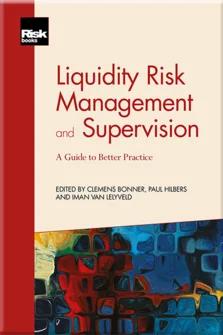Liquidity Buffer Management and Banks’ Counterbalancing Capacity
Jill Cetina and Katherine Gleason
Introduction to ‘Liquidity Risk Management and Supervision’
Liquidity Regulation, the 2007-9 Crisis and the Regulatory Response
Sources of Liquidity Risk: Theory and Empirical Evidence
The Process of Liquidity Supervision
How to Implement ILAAP: Lessons Learned at Rabobank
Liquidity Risk Management Strategy and Tolerance
Liquidity Buffer Management and Banks’ Counterbalancing Capacity
Bank-Level Liquidity Stress-Testing
Contingency Funding Plans
Liquidity Transfer Pricing
Intraday Liquidity Risk Management
Putting Liquidity Risk Management into a Wider Context
Macroprudential Liquidity Stress Tests
A Simple Macroprudential Liquidity Buffer
Chapters 1–3 discussed how supervisory expectations about a bank’s liquidity buffer evolved following the 2007–9 financial crisis, after it became apparent banks’ liquidity buffers were too small and, in some cases, contained assets that were not of sufficient liquidity quality to ameliorate the stress banks were under. The Basel Committee on Banking Supervision (BCBS) “principles for sound liquidity risk management and supervision” established the principle that banks should maintain a cushion of unencumbered, high-quality liquid assets (HQLA) to be held as insurance against a range of liquidity stress scenarios (Basel Committee on Banking Supervision 2008). The BCBS later quantified that principle via a new short-term liquidity standard, the liquidity coverage ratio (LCR) (Basel Committee on Banking Supervision 2013a). However, both the “principles” and the LCR are rooted in long-standing best practices: using short-term cashflow metrics to evaluate potential liquidity mismatches and setting aside a buffer of HQLA to cover expected and unexpected shortfalls.3535See, for example, Moody’s net cash capital tool in Matz and Neu (2007, p. 258) and also Board of Governors of the
Copyright Infopro Digital Limited. All rights reserved.
As outlined in our terms and conditions, https://www.infopro-digital.com/terms-and-conditions/subscriptions/ (point 2.4), printing is limited to a single copy.
If you would like to purchase additional rights please email info@risk.net
Copyright Infopro Digital Limited. All rights reserved.
You may share this content using our article tools. As outlined in our terms and conditions, https://www.infopro-digital.com/terms-and-conditions/subscriptions/ (clause 2.4), an Authorised User may only make one copy of the materials for their own personal use. You must also comply with the restrictions in clause 2.5.
If you would like to purchase additional rights please email info@risk.net











